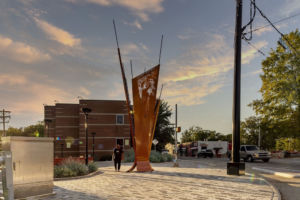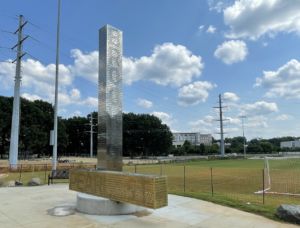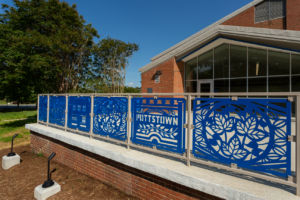Public Art Can’t Replace What’s Gone, But It Can Honor the Past and Inform the Future

By page leggett
What’s been erased can never be restored.
That’s just one problem with tearing down history. There comes a time that people long for what’s no longer there. And it’s too late.
All we can do – a moral imperative that never seems adequate – is commemorate what’s missing. In its role managing the public art programs for the city and county, ASC plays a vital role in highlighting Charlotte’s history. And several recent projects pay homage to Charlotte-Mecklenburg’s Black history.
- At Five Points Plaza in historic West End, Charlotte artist, architect and teacher Stacy Utley worked with Durham-based architect Edwin Harris to create “Excelsior,” a two-part work meant to be viewed as a whole.
- At Pearl Street Park, Cliff Garten (a California-based artist) paid tribute to the once-thriving and now-gone Brooklyn neighborhood, a Black community founded in what is now uptown Charlotte in the late 1800s and destroyed during the “urban renewal” era.
- Michele Turner (a former Charlotte artist who recently moved to Texas) created “Community,” a laser-cut, powder-coated design for the railing at the entrance of the renovated David B. Waymer Recreation Center at the historic Torrence-Lytle School, established in 1937 as the first high school for Black students in northern Mecklenburg County. The midcentury modern gymnasium was built in 1957 as an addition.
ASC’s approach to public art is turnkey, said Todd Stewart, the organization’s vice president for public art.
“We scope out the potential public art opportunities for each large construction project and then release a call to artists; manage that whole process; contract with artists and help them dialogue and correspond with project architects and community members to ideate, develop their concepts and eventually build and install.”
Public input is a requirement – one Utley, who designed the companion pieces for Five Points Plaza, took seriously.
“You know the art piece is going to be in that community and it’s going to be viewed by people who live there, work there, who pass by it every day and experience it,” he said. “We wanted to have engagement sessions to talk to the people in the community, whether they’ve been there for four months or over 40 years.”
There’s always a partnership between artist and community – and ASC facilitates that.
“We create really strong working relationships with the artists,” Stewart said. “We also partner with the Public Art Commission, a nine-member volunteer board with appointees from the city, county and ASC. They are responsible for formalizing the artist selection and they oversee the approval of each design phase. What the Public Art Commission board is looking for is the appropriateness of this project to the context in which it’s being delivered. They’re seeing how it looks cohesively with the overall [building] project and how it creates a sense of place.”
‘THE CENTER OF MY UNIVERSE’

A sense of place is especially important at Pearl Street Park, where there’s now a monument (“Brooklyn Stories”) to the lost Brooklyn neighborhood.
“Brooklyn,” said Arthur Griffin, former Brooklyn resident and a former Charlotte City Councilman who met with Garten during the planning process, “was the center of my universe.”
Pearl Street Park, he said, was “where our football team practiced because we didn’t have a stadium. We didn’t have an appropriate space for the band to practice, so most of the time, the band would practice there to get the perspective of a football field.
“I can’t even begin to tell you about all of the children and families that participated in that park long before I did. So, I think that artwork embodies not just my experience but the experiences of African-Americans that grew up in the Brooklyn area.
He hopes newcomers to Charlotte – as well as long-time Charlotteans – see it and “recognize and appreciate the contributions of all the residents of Charlotte – including African-American residents – that helped pave the way for so many of the successes that Charlotte has been known for.”
Eric Scott, director of exhibits and digital experiences for the Levine Museum of the New South, got to know Brooklyn’s history intimately. The interviews the museum conducted with former Brooklyn residents informed the museum’s exhibition – and were used as the stories engraved into the public art.
“I think the stories that were shared … speak to the significance of the neighborhood … to the social capital that was dismantled, the urban renewal, that kind of injustice and the weight of displacement that happens.”

James Williams, a planner with Mecklenburg County Park and Recreation, worked with ASC and Turner to bring new life and bold color to the historic Waymer Gym.
Turner met with historians and residents, including Bee Jay Caldwell and Verona Wynn, who provided significant details about the community’s history. Caldwell’s book “Historic Pottstown Families,” was another resource. Both had strong memories of Torrence-Lytle High School and of community member Otha Potts and his farmland.
“Mrs. Caldwell told me he raised cotton, which is why I put cotton leaves on every other rail and also to give the image of farmland,” Turner said in her artist statement. “The repetition also helps to pull the rails together as far as design.”
The high school taught farming techniques, sustainability and literacy, Williams said.
“That was very important to the community and it was a focus for doing better, for moving forward,” Williams said.
“Now, when you walk up into the gym, you see this blue – the school’s color,” he continued. “This bright blue railing and inside the motif of the balustrade you see in the images that she picked up from the history and the narrative and the stories of these families.”
‘A REAL SENSE OF COMMUNITY’
There’s a poignancy to bringing artwork to life that commemorates a lost landmark – or an entire neighborhood. Stewart feels it, but he also said that a community is its people and not just collection of buildings. And even though Brooklyn was lost to “urban renewal,” former residents of Brooklyn keep the place alive.
“A community is its people, much more than a place,” he said. “So, although they’re dispersed, those community members still meet. They still have regular reunions of Second Ward High that happened in Pearl Street Park and going to these meetings, you get a sense that each resident is still strongly involved in the lives of others, and there’s a real sense of community in that way.
“But having a community taken – that’s something I can’t understand. Artists are empathetic by nature and they – and we – get caught up in that. It brings up emotions, not just the joy of hearing these stories … but a bit of anger at what happened.
“You want to tell the truth,” he said. “You want to expose what happened. Working for municipalities, you do that in a way that’s respectful, and also respectful to the community members – so it’s not portraying them as victims. It’s a tangled web that these artists have to navigate.”
Like all public art, the latest projects belong to the people of the city and county.
“Public art is a true process that involves a number of stakeholders and partners,” Stewart said. “These works acquire meaning over time. After they’re installed, hopefully, communities get to live with them for decades, and they become part of those communities.”

